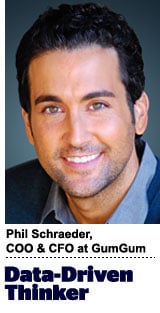 “Data-Driven Thinking” is written by members of the media community and contains fresh ideas on the digital revolution in media.
“Data-Driven Thinking” is written by members of the media community and contains fresh ideas on the digital revolution in media.
Today’s column is written by Phil Schraeder, chief operating officer and chief financial officer at GumGum.
You’re more likely to win the lottery than click on a banner ad. That may be funny, but it’s not a joke.
While I wish you luck on your next Powerball purchase, that aforementioned stat says much more about the state of advertising than it does about your chances of becoming a millionaire.
The internet is packed full of ads, but users just don’t care about them. That’s largely because publishers have exhausted the real estate on their sites with every possible ad. It’s not so much an issue of quality – the quantity has just gotten overwhelming. As a result, users practically flinch whenever a new page loads because they expect some banner, pop-up or retargeted product to interrupt their time online.
There is also ad blocking, which some estimate has increased by more than 40% globally in the last year. With so many people tuning out marketing efforts on their favorite websites, publishers risk undermining the entire digital ad space. What good is a 100% fill rate if nobody can actually see the ads being served?
But this doesn’t have to be the case. Both publishers and advertisers can benefit from rethinking how they approach the stocking up of websites with marketing messages. Instead of reaching for short-term revenue by maximizing fill rates, publishers could appeal to bigger audiences over the long term by reducing them. In turn, that could also increase the effectiveness of the ads.
If readers only see one or two ads per page compared to 10, those select few placements may make more of an impact, especially if they are smartly targeted.
Though requested fill rates vary depending on business goals – say, to provide greater fill on one product to eliminate or reduce the fill on another product – many premium publishers are lowering their fill rates to ensure a high-quality user experience. Perhaps they feel the pressure to bring in every dollar possible at a time when there’s so much competition for user attention across the web. But lowering fill rates doesn’t mean they’ll have to sacrifice revenue.
Arguably, a minimalist fill-rate approach could even lead to more revenue. Sites that don’t bombard their readers with ads end up with better user experiences (UX) and the potential for higher viewability. If users are more likely to come back to a site that respects UX, then the publisher may be able to treat its scarcer ads as premium offerings that could command higher rates. In this case, less is ultimately more.
Additionally, these publishers could focus more on investing in other areas outside of the traditional ad experience that bring value to the consumer, such as native or subscription perks.
Interestingly, nearly a third of ad-blocking consumers in one survey [PDF] said they were “open to some types of advertising. Intrusive ad formats were the key reason why they chose to block ads.” So the desire to engage with ads is clearly there for some, but today’s saturated system has turned them off. Now, the onus is on those in the industry to address how it can create a healthier ad market in the future.
Publishers still have the chance to adapt the way they serve ads to regain the trust of their audiences. But if not, they might be better off just trying to win the lottery.
Follow GumGum (@GumGum) and AdExchanger (@adexchanger) on Twitter.












